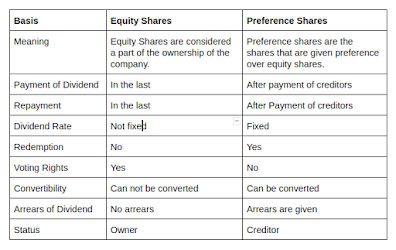Investments are important in today’s uncertain age. You can not depend on a single source of income for fulfilling your needs. Everybody should invest in something to gain an additional income. If you want to make an investment in the shares of the company, then before purchasing you should be informed about the types of shares and the difference between them. If you make an uninformed investment, there are good chances that you might face losses from your investment. There are two types of Difference Between Equity Shares and Preference Shares of a Company. Now let’s know about them in detail.
Preference Shares
Preference shares are the types of shares that are given preference over the equity shares while providing dividends to the shareholders and during the liquidation of the company or redemption of shares. The preference shareholders receive a dividend at a fixed rate already specified on the share certificates. Unlike equity shareholders, the preference shareholders are not considered the owners of the company.
The word “preference” clearly shows that the preference shareholders are given preference at the time of the liquidation of the company and while the payment of dividends and thus are called “preference shares”. The preference shareholders are given a preference in liquidation and payments but unlike the equity shareholders, they do not enjoy any voting rights in the meetings and other important decisions of the company. In the case of liquidation of the company, firstly, the creditors are repaid and then the preference shareholders. The equity shareholders are the last ones to be repaid. The preference shareholders are also given arrears if the dividend for any previous year is not provided to the shareholders.
Types of Preference Shares
- Participating Preference Shares/ Non-Participating Preference Shares
- Convertible Preference Shares/ Non-Convertible Preference Shares
- Cumulative Preference Shares/ Non-Cumulative Preference Share
Equity Shares
Also termed as ‘General Shares’, equity shares are considered a part of the total capital of the company. The equity shareholders are called the owners of the company. Equity shares are the type of share that is not given any preference during the liquidation of the company or while payment of dividends. The rate of dividend of the equity shareholders is not fixed. There may be times where such shareholders may not get any dividend at all. The dividend provided depends upon the profit earned by the company. The decision of rate and amount of dividend is decided by the directors of the company. Unlike the preference shareholders, the equity shareholders have the right to vote in the general and special meetings of the company. They also have the right to appoint or remove any director or auditor of the company.
Types of Equity Shares
- Sweat Equity Share
- Authorized Share Capital
- Issued Share Capital
- Subscribed Share Capital
- Paid-up Capital
- Rights Share
- Bonus Share
Conclusion
While making an investment, you can choose between preference shares and equity shares according to your needs. If you want a stable income from investment then you should opt for preference shares but if you want to be an owner in a company, then you should invest in equity shares. Other features of the types of shares should also be kept in mind before making an investment and an informed decision should be taken thereafter.
SAG RTA, most important & Rajasthan's 1st RTA Agent Company that provides one of the best services for RTA. The company has been granted the role of a registrar and transfer agent via authorization by the Securities and Exchange Board of India.


No comments:
Post a Comment